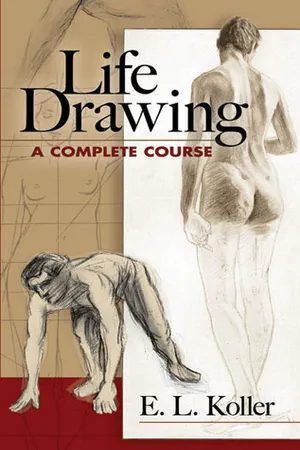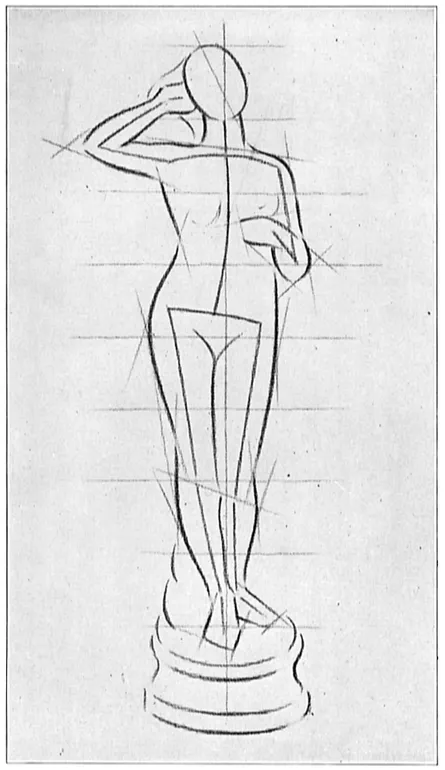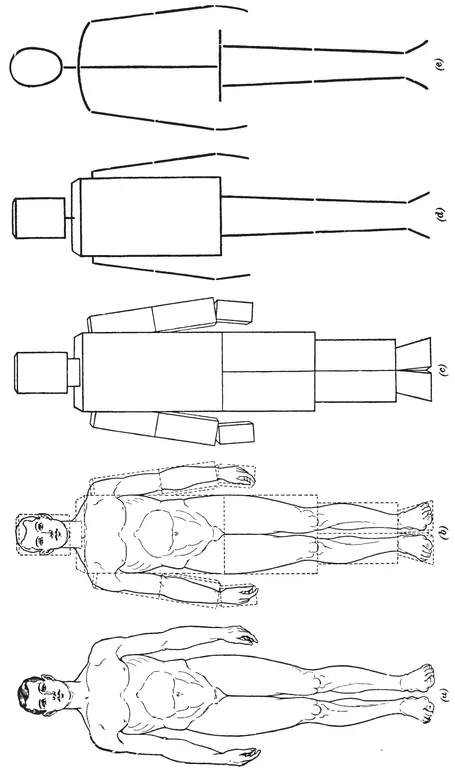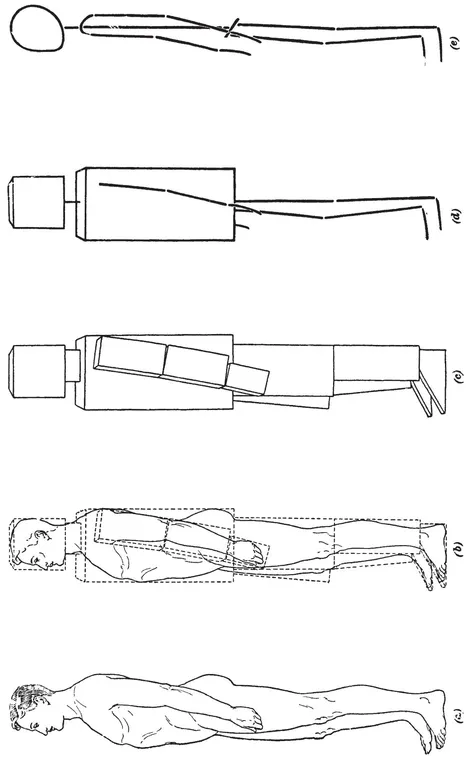
- 224 pages
- English
- ePUB (mobile friendly)
- Available on iOS & Android
eBook - ePub
About this book
The human figure, with its myriad curves and contours, can be challenging for anyone to draw. In this invaluable reference, well-known art instructor and author E. L. Koller simplifies the process, making it easy for artists to learn new methods of rendering the figure—in action and repose—with accuracy and style.
Using figure-drawing exercises, numerous photos, and illustrations, Koller reduces the task at hand into manageable steps for intermediate and advanced artists. Beginning with drawing basics, this step-by-step guide explores the structure of the human figure and the comparative proportions of child and adult figures, showing how to depict individual parts of the head and body, facial expressions, and gestures. It also shows the merits of sketching from memory; drawing from casts, photographs, and living models; and sketching both undraped and costumed figures. Once the still figure is mastered, the artist can explore the more challenging action poses, including walking, running, and catching. Filled with guidance and insight on the human form, Life Drawing is an essential addition to every artist's reference shelf.
Using figure-drawing exercises, numerous photos, and illustrations, Koller reduces the task at hand into manageable steps for intermediate and advanced artists. Beginning with drawing basics, this step-by-step guide explores the structure of the human figure and the comparative proportions of child and adult figures, showing how to depict individual parts of the head and body, facial expressions, and gestures. It also shows the merits of sketching from memory; drawing from casts, photographs, and living models; and sketching both undraped and costumed figures. Once the still figure is mastered, the artist can explore the more challenging action poses, including walking, running, and catching. Filled with guidance and insight on the human form, Life Drawing is an essential addition to every artist's reference shelf.
Frequently asked questions
Yes, you can cancel anytime from the Subscription tab in your account settings on the Perlego website. Your subscription will stay active until the end of your current billing period. Learn how to cancel your subscription.
At the moment all of our mobile-responsive ePub books are available to download via the app. Most of our PDFs are also available to download and we're working on making the final remaining ones downloadable now. Learn more here.
Perlego offers two plans: Essential and Complete
- Essential is ideal for learners and professionals who enjoy exploring a wide range of subjects. Access the Essential Library with 800,000+ trusted titles and best-sellers across business, personal growth, and the humanities. Includes unlimited reading time and Standard Read Aloud voice.
- Complete: Perfect for advanced learners and researchers needing full, unrestricted access. Unlock 1.4M+ books across hundreds of subjects, including academic and specialized titles. The Complete Plan also includes advanced features like Premium Read Aloud and Research Assistant.
We are an online textbook subscription service, where you can get access to an entire online library for less than the price of a single book per month. With over 1 million books across 1000+ topics, we’ve got you covered! Learn more here.
Look out for the read-aloud symbol on your next book to see if you can listen to it. The read-aloud tool reads text aloud for you, highlighting the text as it is being read. You can pause it, speed it up and slow it down. Learn more here.
Yes! You can use the Perlego app on both iOS or Android devices to read anytime, anywhere — even offline. Perfect for commutes or when you’re on the go.
Please note we cannot support devices running on iOS 13 and Android 7 or earlier. Learn more about using the app.
Please note we cannot support devices running on iOS 13 and Android 7 or earlier. Learn more about using the app.
Yes, you can access Life Drawing by E. L. Koller in PDF and/or ePUB format, as well as other popular books in Art & Art Techniques. We have over one million books available in our catalogue for you to explore.
Information
THE HUMAN FIGURE

Method of Blocking in, and Proportioning, the Idealized Classic Figure Eight Heads High. The Living Model of the Female Figure is Considered as Only Seven Heads High.
PLACE OF HUMAN FIGURES IN ILLUSTRATING
1. Four Stages in Learning to Draw.—The use of the human figure usually occupies a prominent part in the composition and drawing of pictorial and decorative work. But the human figure is extremely difficult to draw, being composed of so many subtle curves and contours, and such delicate gradations of light and shade in its modeling, that, before these can be drawn and rendered properly, training must be had in drawing more simple forms. For that reason training has been given in line drawing and eye measurement, in model drawing in outline, and in drawing from inanimate models to portray light, shade, and shadow, this preliminary training serving as a series of graded steps leading up to the drawing of the human figure. The next natural and logical step is to draw the human figure, which may be considered the fourth stage in learning to draw.
2. Proper Foundation for Figure Drawing.—Before one can draw the human figure he must be thoroughly familiar with the proportions, measurements, and contours of the human figure as a whole, and of each of its individual parts. To give such a familiarity is the purpose of this subject, which may be considered as a sort of reference book. The information given here must be thoroughly understood, and practice secured in actually sketching such proportions, before the practical work of drawing human figures in various postures and actions can be taken up. In the following subjects the training in figure drawing is extended to include drawing the figure in repose and in action.
Owing to the demand, by a certain class of art students, for a short-cut method of drawing the human figure, unprincipled persons posing as instructors have denied the necessity of a well-laid foundation for drawing the human figure. Their so-called short cuts for teaching the drawing of this, the most complicated of all subjects, however, do not train one to do original work in actually drawing from the living model. They teach only facility in copying the work of others, an accomplishment that is of no practical value to the prospective illustrator.
3. Foundation for Caricaturing and Cartooning.—A careful systematic study of the human figure is absolutely necessary for any one who desires to draw caricatures and cartoons. Many persons, because of the attraction of the pictures in the comic sections of newspapers and in humorous weekly and monthly magazines, acquire a strong desire to do work of this kind. They, therefore, often study the work of their favorite cartoonists thinking that when able to copy this work satisfactorily their training is done. These persons confuse the ability to copy with the ability to originate.
It is impossible to compose and draw cartoons, caricatures, or original pictures of any kind, unless one has had a thorough graded training in drawing, and no one can draw the human figure without a full knowledge of the rules governing its proportions, etc. Caricatures are but drawings of a face or figure with its features exaggerated and cannot be drawn, except from a copy, until the ability to draw the face or figure in its normal proportions has been obtained. This ability is acquired only by a systematic study of figure drawing, facial expression, etc., such as will be given in this and following Sections.
The student is strongly advised against the practice of copying caricatures and cartoons made by professional artists, or making comic drawings in imitation of some cartoonist’s individual style. Such a practice will be of absolutely no value in training him to draw the human figure, or in acquiring an individual style.
PROPORTIONS OF HUMAN FIGURE
FRAMEWORK OF FIGURE
4. Application of Principle of Structural Forms. The transition from drawing inanimate models in outline and light and shade to drawing the human figure is not, in reality, an abrupt one. As the curved line is based on the straight line and can be drawn more easily and accurately if straight construction lines are drawn, and as solids with curved sides and edges are based on solids with straight sides and edges, so may the human figure and its individual parts be based on rectilinear shapes of given proportions. This is well shown in Figs. 1 and 2, which give the full-front and side views of the same figure. In each case, (a) shows the fully modeled figures; (b) shows the figure and all its parts enclosed within their proper frameworks; (c) shows the frameworks alone.
5. From these two illustrations it is evident that certain principles govern the drawing of the human figure. These principles must be clearly understood and kept in mind at all times; they are as follows:
1. The human figure is a solid, for it has length, width, and thickness; it is not, however, a hard, rigid, unbending solid like a piece of wood or marble.
2. Each individual part, such as the head, the trunk, the arm, etc., is also a solid.
3. The head may be enclosed within an imaginary block form slightly longer than a cube; the neck within a half cube the trunk, from the neck to where the legs join the body, within a solid about twice as high as wide but not quite as thick, or deep, as it is wide; the legs and arms within hinged pairs of solids, each section of the pair (corresponding to upper arm or upper leg and lower arm or lower leg) being about twice as long as wide; and the feet within wedge-shaped blocks as shown.


4. These blocks or solids are not fastened rigidly together at their points of joining, but may be considered as being hinged so as to be able to move in various directions.
If these few general blocking-in shapes are fixed well in mind it will always be possible to think of the figure, no matter how placed or in what complicated postures, as being made up of flexible solids, properly joined, and of the proportions given. The purpose, therefore, of these illustrations is not to furnish a quick method of drawing the figure, but to show the basic framework of the figure and its parts, considered from the exterior.
6. Foreshortening of Human Figure.—As people do not always stand erect, soldier like, but assume postures in which one part of the body is much closer to the observer than other parts, the principles of foreshortening must often be applied to drawings of the human figure. The application of these principles, however, is not difficult when the body is thought of as being enclosed within flexible rectilinear solids. Whenever it is desired to show the figure in a...
Table of contents
- Title Page
- Copyright Page
- Table of Contents
- THE HUMAN FIGURE
- THE FIGURE IN REPOSE
- THE FIGURE IN ACTION
- A CATALOG OF SELECTED DOVER BOOKS IN ALL FIELDS OF INTEREST